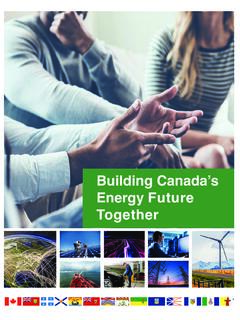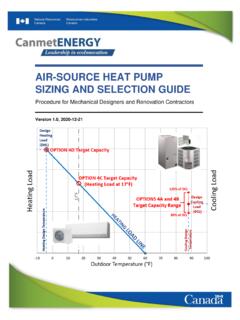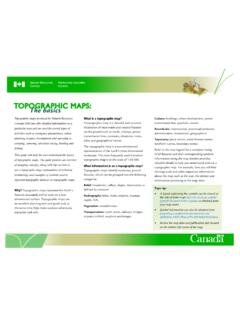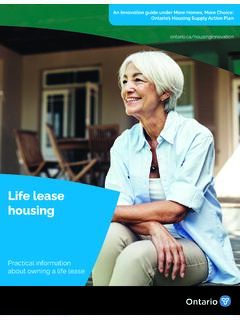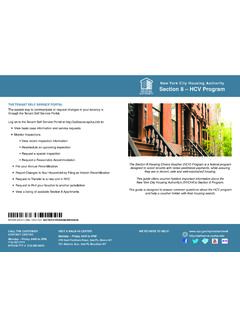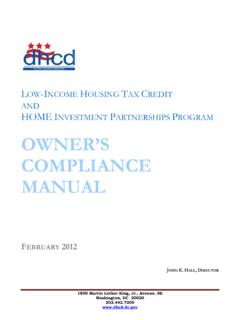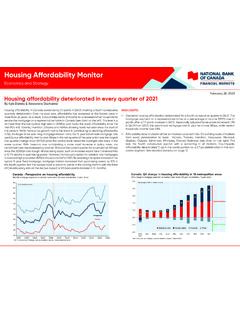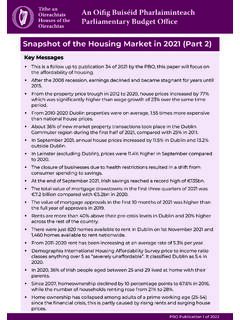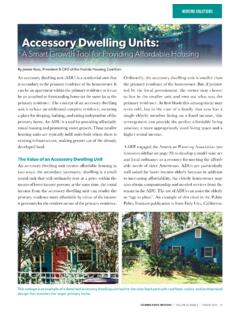Transcription of Net Zero Energy and Net Zero Energy Ready Housing ...
1 Net Zero Energy and Net Zero Energy Ready Housing Lessons learned and key findings from the ecoEII Net-Zero Demonstration and the R-2000 Net-Zero Energy Pilot2019 Cat. No. M144-292/2019E-PDF ISBN 978-0-660-30266-9 Table of Contents .. of a Net-Zero Energy House .. from Prior NZE Initiatives .. Builder Experiences .. 4 Benefits of NZE/NZER Housing .. 4 Costs and 4 Construction practices .. 4 Code authority and Local Electrical Distribution Company (LDC) approvals .. 5 Homeowner awareness of NZE technologies and their benefits .. 6 House design Improvements through iteration .. 6 from the Pilot .. 7 Principles of NZE/NZER house design .. 7 Attributes of the Pilot 7 How the Pilot houses built differ from previous NZE designs .. 9 Replicability .. 10 Work .. 11 Monitoring of NZE and NZER houses .. 11 Long-term envelope performance.
2 11 Remarks .. 12 ANNEX A: .. A-1 ANNEX B: .. B-1 1. IntroductionIn 2013, Natural Resources Canada (NRCan) launched two initiatives: the R-2000 Net-Zero Energy Pilot (R -2000 NZE) and the ecoEII Net-Zero Energy Housing Demonstration Project (ecoEII). The R-2000 NZE was a pilot program to label Net-Zero Energy (NZE) houses. This initiative drew upon NRCan s next generation draft 2014 R-2000 Standard, the EnerGuide Rating System (ERS) and the HOT2000 modelling software, with new procedures that allowed builders to demonstrate that their houses would generate as much renewable Energy as they would consume annually. NRCan issued a call for applications for the R-2000 NZE, whereby participating builders constructing high-performance houses received technical support for modelling the Energy performance of their houses. Although fifteen builders applied to the R-2000 NZE initiative, only two went on to construct and label one NZE house each as part of the Pilot (Annex A).
3 The remaining builders did not complete the NZE labelling initiative for a variety of reasons, including: They opted to withdraw from the Pilot rather than adapt their house designs to meet the Pilotrequirements; They were unable to meet the final labelling deadline; They made use of ineligible technologies; or, They did not install the photovoltaic (PV) system required to achieve the NZE performance s ecoEII was led by Owens Corning, with funding support from NRCan s ecoEnergy Innovation Initiative. Five production home builders (Annex A) from across Canada (Nova Scotia, Quebec, Ontario and Alberta) were selected to build net-zero Energy market- Ready houses. This project saw the builders construct 11 NZE single-family dwellings, one four-unit NZE row house, one NZE MURB (comprised of 6 units) and five NZER houses (this builder applied the initiative s design and modelling procedures but elected not to install the renewable Energy systems required to achieve net-zero Energy performance).
4 The ecoEII builders, having constructed the NZE houses and MURB units using the same standards, methodologies and tools as those participating under the R-2000 NZE, were also included in the R-2000 NZE Labelling Pilot (outlined above). Between the two initiatives, a total of 13 NZE single-family dwellings, one four-unit NZE row-house, one six-unit NZE multi-family building and five NZER houses were constructed. For the purposes of this paper, the term Pilot shall refer to all the participating builders of net-zero Energy Housing , as outlined above; otherwise, each initiative will be referred to separately. To demonstrate that their houses achieved NZE or NZER performance, Pilot builders had to comply with specific eligibility, modelling, testing and certification/labelling requirements. The Pilot houses are among the most advanced houses ever constructed in Canada in terms of Energy performance.
5 They draw upon 40 years of research and innovation in Energy -efficient Housing (see Table 1) and benefit from the contributions of Canadian home builders, manufacturers, universities, federal and provincial governments, and the homeowners and early adopters that invested in those houses. The ecoEII Net-Zero Demonstration and the R-2000 Net-Zero Energy Pilot Lessons Learned and Key Findings 1 The Pilot houses represent an important step towards the broad adoption of net-zero and low-carbon home design and construction. They incorporate technologies, practices and learnings from the Canada Mortgage and Housing Corporation s EQuilibrium Sustainable Housing Demonstration Initiative (EQuilibrium), Canada s first effort to work with leading builders to plan, design, build, demonstrate and monitor net-zero houses, which were adapted for application in production homebuilding.
6 As such, the Pilot marks a key milestone in moving towards some of the goals of the Pan-Canadian Framework on Clean Growth and Climate Change ( Net-Zero Energy Ready building codes by 2030). Table 1: Chronology of Canadian Advanced Housing Programs and Initiatives Year/Time Frame Initiative/Program 1977 Saskatchewan Conservation House 1980 Super Energy Efficient Homes (SEEH) Program 1982 Present R-2000 Program 1991 1993 Advanced Housing 1998 Present Canadian Centre for Housing Technologies (CCHT) 2005 2009 EQuilibrium Sustainable Housing Demonstration Initiative 2007 Factor 9 House 2013 2016 R-2000 Net-Zero Energy Pilot 2013 2016 ecoEII Net-Zero Energy Demonstration Project 2017 CHBA Net-Zero Home Labelling Program (v1) This document summarizes key findings related to the design and construction of the Pilot houses, including the experiences of the builders participating in the program, and highlights how the Pilot programs built upon the knowledge gained under EQuilibrium.
7 Of a Net-Zero Energy HouseFor the purposes of this paper, Net-Zero Energy and Net-Zero Energy Ready are defined below: A Net-Zero Energy (NZE) house is a house that produces as much Energy from on-site renewable Energy sources as it consumes each year. NZE houses are designed, modelled and constructed in accordance with NRCan s R-2000 Net-Zero Energy Pilot technical requirements. A Net-Zero Energy Ready (NZER) house is a variant of the NZE house in which the builders have not installed the renewable Energy generation system. NZER homes are also designed, modelled and constructed in compliance with NRCan s R-2000 Net-Zero Energy Pilot technical requirements, but instead of installing the renewable generation systems, builders provide home buyers with a design of a suitable system that would enable the home to reach net zero, and provisions within the home for installing such a system in the future.
8 The Pilot houses contain a range of proven and commercially available technologies and building practices designed to reduce the amount of Energy a house requires to keep occupants comfortable. These houses share three common characteristics: Building envelope measures: NZE and NZER houses incorporate levels of insulation thatgenerally well exceed current building and Energy code requirements, achieve exceptional levelsof airtightness and have fewer thermal bridges than code-built houses. With improved windowsThe ecoEII Net-Zero Demonstration and the R-2000 Net-Zero Energy Pilot Lessons Learned and Key Findings 2 and insulation and fewer air leakage pathways, these houses reduce the amount of heat lost in the winter and heat gained in the summer, making them much more Energy efficient while also keeping occupants more comfortable. The houses are also quieter since outside noise penetration is significantly reduced by the improved envelope.
9 High-efficiency equipment: NZE and NZER houses use very efficient technologies for space conditioning (heating and cooling), water heating, equipment control systems, ventilation equipment, lighting and appliances (such as Energy STAR ), thereby reducing the house s Energy needs even further and helping to improve occupant comfort. NZE and NZER houses also incorporate Energy or heat recovery ventilators (E/HRVs) to ensure a healthy environment by exhausting contaminates and providing occupants with fresh air to improve the indoor air quality while minimizing Energy use. Load reduction measures: NZE and NZER homes use highly efficient lighting to reduce electricity use and low-flow fixtures to reduce water consumption. Some builders may opt to include high-efficiency appliances as well. To offset their annual Energy consumption demands, NZE houses also incorporate on-site renewable Energy technologies such as solar photovoltaics.
10 NZER houses, on the other hand, include provisions to allow homeowners to more easily install renewable Energy systems at a later date should they decide to do so. 3. Improvements/Progress/Changes f rom Prior NZE Initiatives From a modelling and certification perspective, the lessons and experiences from EQuilibrium led NRCan to introduce two significant changes in the development of the Pilot s requirements: 1. Equipment performance ratings: While prior NZE and low- Energy demonstrations placed few limits on the technologies that could be used, NRCan introduced a new requirement that all mechanical and renewable systems be modelled in HOT2000, using data from an accepted performance test standard. This requirement meant that an emerging technology that had not been previously tested for use in Canada would be ineligible in the Pilot. The purpose of this requirement was to demonstrate that builders across Canada could utilize readily available technology to build NZE/NZER homes.


